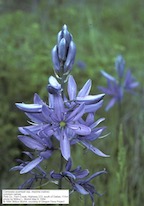|
2020 NPSO Annual Meeting Cancelled Due to the COVID-19 pandemic, and in the best interests for the health and safety of our members, the Cheahmill Chapter has decided to cancel the Annual Meeting this year. While the number of new cases should decline over the next several weeks and months, subsequent waves of COVID-19 are likely to recur once social distancing is relaxed. We are exploring hosting the meeting next year (2021) at Spirit Mountain Lodge and offering much the same program. If you have already sent in your registration form and payment, your checks will be shredded. Those whose checks were already deposited will receive a refund. We look forward to seeing all of you in 2021, hopefully at Spirit Mountain. Please stay safe and healthy through this difficult time. |
NPSO 2020 Annual Meeting
May 29 - 31 Spirit Mountain Lodge, Grand Ronde, Oregon
 View of Salmon River Estuary and Camp Westwind from Cascade Head, locations of four field trips this year
View of Salmon River Estuary and Camp Westwind from Cascade Head, locations of four field trips this year
In June 1842, Charles Wilkes of the United States Exploring Expedition (1838-1842) described what is now Yamhill County’s Eola Hills as being “covered with wallflowers, lupine, scilla, and quantities of ripe strawberries.” Another member of the expedition wrote in his journal of a “prairie all luxuriantly clothed in a rich and heavy coat of vegetation and latterly clothed in flowers, the upland in yellow and the valleys in purple.” As is true elsewhere in the Willamette Valley, historically extensive prairies and oak savannas have been replaced by urban, commercial, and agricultural development, with only a small fraction of the historic landscape remaining. But recent years have shown a resurgence in restoring degraded landscapes and protecting what remains. This is the focus of the 2020 NPSO Annual Meeting hosted by the Cheahmill Chapter.
When early explorers arrived in the area, they recognized that the Valley and surrounding landscapes were not (in modern parlance) climatic climax communities. For example, they were at a loss to explain the presence of such extensive prairies in the Valley when the climate indicated it should be forested. When members of the Hudson’s Bay Company entered the Willamette Valley in September 1826 on their annual trapping expedition south to California, they encountered extensive burning by indigenous peoples. David Douglas, botanist and member of the expedition, exclaimed that there "was not a single blade of grass” on which to feed their horses and lamented that fire was “highly unfavorable to botanizing”! On his return in November, he encountered an altered landscape, now green, “open, rich, level and beautiful.”
In fact, Native Americans had been managing the landscape for millennia, primarily through their use of fire, which kept the valley, foothills, and surrounding forests in early seral stages. This, in turn, made for a more efficient deer hunt and made it easier to gather traditional foods, such as acorns. Fire created environments that encouraged the regrowth of culturally important plants used in basketry, such as hazel, and increased the future yields of foodplants, including camas bulbs, tarweed seed, and many species of berries. Coast Range forests, too, were burned primarily to encourage the growth of berries, such as salal, red huckleberry and salmonberry, and to clear travel routes, especially along ridges.
Today, less than 10% of the pre-settlement forest and less than 1% of the prairie and oak savanna landscapes remain. Recently, conservationists have worked to preserve what remains and, where possible, to restore degraded areas.
Because the Confederated Tribes of Grand Ronde (CTGR) are actively involved in restoring native habitats and growing culturally important native species for introduction to degraded landscapes on their ceded lands, we chose to focus on some of their efforts. This includes hosting the meeting at the Spirit Mountain Lodge, featuring CTGR speakers on Friday night, and visiting sites where the tribes have partnered with others for restoration, including the Institute for Applied Ecology and the USFWS. On Friday night, short presentations will feature Lucia Summers, Oregon’s first resident botanist, who lived in the area shortly after the Grand Ronde Reservation was created (Ed Alverson, Lane County Natural Areas Coordinator), tribal efforts to grow culturally important native plants (Jeremy Ouja, Native Plant Nursery Supervisor), their use of fire for habitat restoration (Colby Drake, Silviculturalist/Fire Protection Program Manager), and how the academic field of restoration ecology is informing their practices (Lindsay McClary, Restoration Ecologist).
In his banquet presentation on Saturday night, Ed Alverson will add historical perspective to our theme of contemporary restoration and conservation. Historical records, reconstructed from government land surveys in the 1850s, serve as benchmarks for how to best manage these lands today.
Situated between the Willamette Valley and the coast, the Spirit Mountain Lodge in Grand Ronde is an ideal central location for our meeting. We offer field trips in the valley, at the coast, and in the Coast Range, including oak savannas, prairies, coastal forests, beaches, and estuaries. Many of the field trips visit restoration areas or are actively managed for culturally significant plant species or for the protection of state and federally listed species. Because wine production is a major agricultural land use in the Valley, several trips include a visit to a winery committed to protecting and restoring prairies and oak savannas on their lands.
Only NPSO members may participate in Annual Meeting activities. You may join NPSO or renew your membership at www.npsoregon.org/membership.html or when you mail in your Registration Form.
Questions? Email annualmeeting@npsoregon.org .


